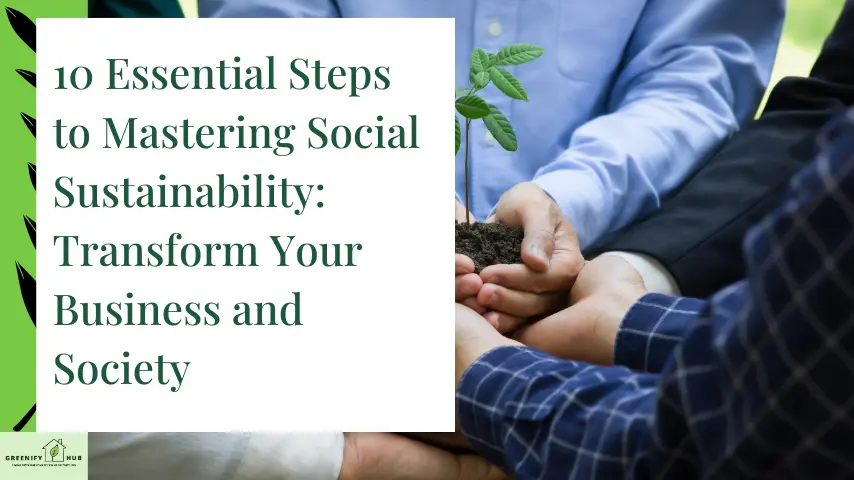10 Essential Steps to Mastering Social Sustainability: Transform Your Business and Society

Social sustainability is a crucial aspect of the broader sustainability movement. It focuses on creating and maintaining a society that’s fair, diverse, and connected.
But what does that really mean?
Imagine a world where everyone has access to education, healthcare, and job opportunities. A world where your gender, race, or background doesn’t limit your potential. That’s the goal of social sustainability.
It’s about more than just reducing our environmental impact. It’s about making a positive impact on people’s lives.
For businesses, social sustainability is becoming a key part of their social responsibility drive. Companies are realizing that their success isn’t just about profits. It’s also about how they treat their employees, customers, and communities.
Take Patagonia, for example. They’re not just selling outdoor gear. They’re championing fair labor practices and environmental conservation. Their commitment to social sustainability has earned them loyal customers and a reputation as a responsible business.
Social sustainability isn’t just a nice-to-have. It’s becoming a must-have for businesses that want to thrive in the long term.
Social sustainability goes beyond environmental concerns, focusing on creating a fair and equitable society while driving business success through responsible practices.
Aligning Social Sustainability with UN Sustainable Development Goals
The United Nations has set out 17 Sustainable Development Goals (SDGs) as a blueprint for a better world. These goals are like a roadmap for sustainable business strategies.
But how do they connect to social sustainability?
Well, many of these goals directly address social issues. For example:
– Goal 1: No Poverty
– Goal 3: Good Health and Well-being
– Goal 4: Quality Education
– Goal 5: Gender Equality
– Goal 10: Reduced Inequalities
When businesses align their practices with these goals, they’re contributing to social sustainability on a global scale.
Take IKEA, for instance. They’ve committed to creating 200,000 jobs for refugees by 2030, aligning with Goal 8: Decent Work and Economic Growth. This isn’t just charity – it’s a sustainable business strategy that addresses social needs while potentially expanding their workforce.
Aligning business practices with UN Sustainable Development Goals provides a framework for implementing social sustainability strategies that contribute to global progress.
RELATED: Mastering the 4 Pillars of Sustainability: Your Comprehensive Guide to a Sustainable Future
The Business Case for Social Sustainability
Why should businesses care about social sustainability? It’s not just about doing good – it’s about smart business strategy.
Improved Financial Performance
Studies show that companies with strong social sustainability practices often see better financial performance. Why? Because consumers are increasingly choosing to support socially responsible businesses.
Enhanced Brand Reputation
A company’s success often hinges on its reputation. Social sustainability initiatives can significantly boost a company’s image, leading to increased customer loyalty and attracting top talent.
Risk Mitigation
In today’s interconnected world, social issues can quickly become business risks. Companies that prioritize social sustainability are better equipped to navigate these challenges.
Innovation Driver
Social sustainability can be a powerful market force for innovation. When businesses focus on solving social problems, they often develop new products or services that open up new markets.
Let’s look at an example:
Unilever’s Sustainable Living Plan is a prime case of social sustainability driving business success. This plan aims to improve health and well-being for more than a billion people, while also reducing environmental impact and enhancing livelihoods.
The result? Unilever’s Sustainable Living Brands are growing 69% faster than the rest of their business and delivering 75% of the company’s growth.
This shows that social sustainability isn’t just an add-on. It’s becoming a core part of successful business strategies, driving growth and innovation while addressing crucial social issues.
Social sustainability is not just altruistic; it’s a smart business strategy that can lead to improved financial performance, enhanced reputation, risk mitigation, and innovation.
RELATED: Mastering the Three Es of Sustainability: A Comprehensive Guide for Businesses
Stakeholder Approach in Social Sustainability
Social sustainability isn’t just about a company’s actions. It’s about how those actions affect everyone the company touches – its stakeholders.
Who are these stakeholders?
– Employees
– Customers
– Suppliers
– Local communities
– Investors
– The environment
A stakeholder approach means considering all these groups when making decisions. It’s about creating value for everyone, not just shareholders.
Take Starbucks, for example. They’ve implemented a comprehensive stakeholder approach:
– For employees: They offer healthcare benefits even to part-time workers.
– For farmers: They have ethical sourcing programs to ensure fair wages.
– For communities: They invest in local economic development programs.
– For the environment: They’re working towards 100% ethically sourced coffee.
This approach has led to an enterprise-wide transformation. It’s not just about selling coffee anymore. It’s about creating a positive impact across their entire value chain.
Adopting a stakeholder approach can lead to more robust social sustainability initiatives. It ensures that a company’s efforts are comprehensive and truly beneficial to the market community they serve.
A stakeholder approach in social sustainability considers the impact on all groups affected by a company’s actions, leading to more comprehensive and effective initiatives.
RELATED: Unleashing Cultural Sustainability: 12 Key Strategies for Thriving Communities
Internal Stakeholder Strategies
Internal stakeholders – employees, managers, and shareholders – are the backbone of any company. Social sustainability starts from within, and here’s how companies can make it happen:
Fostering a People-First Culture
A people-first culture puts employees at the center of the business model. It’s about creating an environment where people feel valued, heard, and empowered.
Google, for instance, is famous for its employee-centric culture. They offer perks like free meals, on-site gyms, and even nap pods. But more importantly, they give employees time to work on personal projects, fostering innovation and job satisfaction.
Promoting Gender Balance
Gender balance isn’t just about equality – it’s about leveraging diverse perspectives for better decision-making.
Salesforce took a bold step by conducting a company-wide audit of salaries and spent $3 million to eliminate gender pay gaps. This action not only improved equality but also boosted employee morale and loyalty.
Implementing Volunteer Programs
Volunteer programs can boost employee engagement while making a positive impact on communities.
Timberland’s Path of Service program gives employees up to 40 paid hours each year to volunteer. This initiative has resulted in over 1 million hours of community service, boosting employee satisfaction and community relations.
Prioritizing Health and Safety
Health and safety practices are crucial for operational efficiency and team morale.
During the COVID-19 pandemic, companies like Microsoft quickly shifted to remote work and provided additional support for employees’ mental health. This proactive approach protected employees while maintaining productivity.
Championing Diversity and Inclusion
Addressing social injustice starts within the company. Diversity and inclusion initiatives can create a more innovative and resilient workforce.
Accenture set clear goals for gender, ethnic, and LGBT+ representation in their workforce. They’ve made significant progress, with women now making up 44% of their global workforce.
Internal stakeholder strategies focusing on employee well-being, equality, and engagement are crucial for building a socially sustainable organization from the inside out.
RELATED: 4 Game-Changing Sustainable Business Practices for Lasting Impact
External Stakeholder Engagement
External stakeholders include customers, suppliers, local communities, and even the environment. Engaging these groups is crucial for comprehensive social sustainability.
Community Engagement
Businesses don’t operate in isolation. They’re part of communities, and their actions have ripple effects.
Walmart’s Community Grants program is a great example. They provide funding to local organizations for projects in areas like hunger relief, environmental sustainability, and education. This not only benefits communities but also strengthens Walmart’s local relationships.
Partnering with Nonprofit Organizations
Nonprofits often have expertise in social issues that businesses lack. Partnerships can lead to more effective social transformation.
Take Microsoft’s partnership with NetHope, a consortium of nonprofits. Together, they’re bringing cloud technology to humanitarian organizations, amplifying their impact in disaster relief and development work.
Sustainable Supply Chain Management
A company’s social impact extends to its suppliers. Ensuring fair practices throughout the supply chain is key to social sustainability.
Patagonia’s Worn Wear program encourages customers to repair, reuse, and recycle their clothing. This initiative not only reduces waste but also promotes a more sustainable consumption model.
Environmental Stewardship
While not traditionally considered a stakeholder, the environment is crucial for long-term sustainability.
Unilever’s Sustainable Living Plan includes commitments to halve their environmental footprint. This benefits the planet and also resonates with environmentally conscious consumers.
By engaging external stakeholders, companies can create a ripple effect of positive change, extending their social sustainability efforts far beyond their immediate operations.
Engaging external stakeholders through community involvement, partnerships, sustainable supply chains, and environmental stewardship extends a company’s social sustainability impact beyond its immediate operations.
Implementing Social Sustainability Standards and Guidelines
Implementing social sustainability isn’t about reinventing the wheel. There are established standards and guidelines that can help businesses navigate this journey.
ISO 26000
This international standard provides guidance on social responsibility. It covers seven core subjects:
1. Organizational governance
2. Human rights
3. Labor practices
4. Environment
5. Fair operating practices
6. Consumer issues
7. Community involvement and development
Global Reporting Initiative (GRI)
The GRI Standards are the world’s most widely used sustainability reporting standards. They help businesses understand and communicate their impacts on issues like climate change, human rights, and corruption.
UN Global Compact
This initiative encourages businesses to adopt sustainable and socially responsible policies. It’s based on ten principles covering human rights, labor, environment, and anti-corruption.
For example, Nestle uses these guidelines to shape their sustainability efforts. They’ve aligned their strategies with the UN Sustainable Development Goals and use GRI Standards for reporting.
By following these established frameworks, sustainability leaders can ensure their efforts align with global best practices. It’s not about ticking boxes, but about integrating these principles into the core of business operations.
Remember, these standards are starting points. The real work lies in applying them to your unique business context and continually improving your sustainability efforts.
Implementing established social sustainability standards and guidelines provides a framework for businesses to develop, measure, and report on their sustainability efforts effectively.
RELATED: Economic Sustainability Unveiled: 10 Key Principles for a Thriving Future
Continuous Improvement in Social Sustainability
Social sustainability isn’t a destination – it’s a journey of continuous improvement. Progressive businesses understand this and constantly strive to do better.
Take Unilever, for example. Their Sustainable Living Plan set ambitious targets for 2020. But they didn’t stop there. They’ve now launched a new set of goals for 2025, pushing their sustainability efforts even further.
This approach of setting new goals and raising the bar is crucial. It keeps companies innovative and responsive to changing social needs.
Here’s how businesses can embrace continuous improvement:
1. Regularly review and update sustainability goals
2. Stay informed about emerging social issues
3. Seek feedback from stakeholders
4. Benchmark against industry leaders
5. Invest in sustainability training for employees
Remember, what was considered progressive yesterday might be the bare minimum tomorrow. The key is to maintain a transformative sustainability ambition that evolves with societal expectations and needs.
Continuous improvement in social sustainability involves regularly setting new goals, staying informed about emerging issues, and maintaining a transformative ambition.
Case Studies: Successful Social Sustainability Initiatives
Let’s dive into some real-world examples of companies leading the way in social sustainability:
Unilever: Sustainable Living Plan
Unilever’s Sustainable Living Plan is a prime example of a comprehensive social sustainability initiative. Launched in 2010, it aimed to decouple the company’s growth from its environmental impact while increasing its positive social impact.
Key achievements:
– Reached 1.3 billion people through health and hygiene programs
– 56% of agricultural raw materials sustainably sourced
– Achieved gender balance in management roles globally
The result? Unilever’s Sustainable Living Brands grew 69% faster than the rest of the business in 2018.
Patagonia: Worn Wear Program
Patagonia’s Worn Wear program is a innovative approach to sustainable consumption. It encourages customers to repair, reuse, and recycle their clothing, challenging the fast fashion model.
Impact:
– 100 tons of clothing repaired instead of replaced
– Created a new market for used Patagonia gear
– Shifted consumer mindset towards longevity over disposability
This initiative not only reduces waste but also creates a new revenue stream through the sale of used gear.
Microsoft: AI for Earth
Microsoft’s AI for Earth program uses artificial intelligence to address global environmental challenges. They provide grants, technology, and expertise to organizations working on issues like climate change, biodiversity, and water scarcity.
Achievements:
– Over 700 grantees in more than 80 countries
– Development of new tools for environmental monitoring and conservation
– Democratizing access to AI technology for environmental organizations
This program showcases how a tech company can leverage its core competencies to drive social sustainability.
These case studies demonstrate how companies can create new products, shift markets, and drive innovation through social sustainability initiatives. They show that sustainability isn’t just about minimizing negative impacts – it’s about creating positive change and new opportunities.
Successful social sustainability initiatives, as demonstrated by Unilever, Patagonia, and Microsoft, can drive innovation, create new markets, and deliver both social and business value.
RELATED: Environmental Sustainability Unveiled: Key Concepts Shaping Our Future
Measuring and Reporting Social Sustainability Impact
Measuring and reporting social sustainability impact is crucial for strategy execution and demonstrating real value. It’s about showing the greatest impact of your efforts.
But how do you measure something as complex as social impact?
Here are some key metrics:
1. Employee satisfaction and retention rates
2. Diversity and inclusion statistics
3. Community investment figures
4. Supply chain audit results
5. Carbon footprint reduction
6. Customer satisfaction related to sustainability efforts
Companies like Salesforce use a stakeholder impact report to showcase their social sustainability efforts. They measure things like:
– Volunteer hours contributed by employees
– Donations to nonprofit organizations
– Progress on diversity and inclusion goals
– Environmental impact reduction
Reporting frameworks like the Global Reporting Initiative (GRI) provide standardized guidelines for sustainability reporting. This allows for comparison across companies and industries.
Remember, it’s not just about the numbers. Qualitative data, like case studies and stakeholder testimonials, can provide rich insights into your impact.
The key is to align your measurements with your social sustainability goals. This ensures you’re tracking what matters most to your strategy and stakeholders.
Effective measurement and reporting of social sustainability impact involves both quantitative metrics and qualitative data, aligned with company goals and standardized reporting frameworks.
Overcoming Challenges in Social Sustainability Implementation
Implementing social sustainability isn’t always smooth sailing. Companies often face hurdles like:
1. Resistance to change
2. Short-term profit pressures
3. Lack of expertise
4. Difficulty measuring impact
5. Balancing multiple stakeholder needs
Take climate change, for instance. Many companies struggle to balance immediate business needs with long-term environmental considerations.
Or consider social injustice. Addressing systemic issues within a company can be complex and uncomfortable.
But these challenges aren’t insurmountable. Here’s how companies can overcome them:
– Educate employees about the importance of sustainability
– Set clear, measurable goals
– Integrate sustainability into core business strategy
– Partner with experts and NGOs
– Communicate progress transparently
Unilever, for example, overcame initial skepticism about their Sustainable Living Plan by consistently demonstrating its business value over time.
Remember, overcoming these challenges often leads to innovation and new growth opportunities. It’s about seeing obstacles as chances for improvement and transformation.
While implementing social sustainability presents challenges, companies can overcome them through education, goal-setting, partnerships, and transparent communication, often leading to innovation and growth.
RELATED: Conservation and Sustainability: 10 Key Differences That Shape Our Planet’s Future
Future Trends in Social Sustainability
The landscape of social sustainability is constantly evolving. Here are some trends shaping its future:
1. Circular Economy: Companies are moving beyond recycling to redesigning products for reuse and regeneration.
2. Stakeholder Capitalism: There’s a shift from shareholder primacy to considering all stakeholders in business decisions.
3. AI for Good: Artificial intelligence is being harnessed to address social and environmental challenges.
4. Transparency and Traceability: Blockchain and other technologies are enabling greater supply chain transparency.
5. Employee Activism: Workers are increasingly demanding their employers take stands on social issues.
These trends highlight the disruptive power of sustainability. They’re driving major transformations in how businesses operate and create value.
For instance, Adidas is exploring fully recyclable shoes, while Microsoft is using AI to combat climate change.
As these trends evolve, they’ll create new growth opportunities for businesses that can adapt and innovate. The future of social sustainability is not just about mitigating risks – it’s about reimagining business models for a more equitable and sustainable world.
Future trends in social sustainability, such as circular economy and AI for good, are creating disruptive changes and new growth opportunities for innovative businesses.
Conclusion
As we conclude our journey through the realm of social sustainability, it’s clear that this transformative approach holds immense potential for businesses and society alike. By embracing these 10 essential steps, you’re not just adapting to market forces; you’re becoming a catalyst for positive change. Remember, social sustainability is an ongoing process that requires commitment, innovation, and collaboration.
As you implement these strategies, you’ll likely witness improvements in financial performance, operational efficiency, and stakeholder relationships. The path to social sustainability may present challenges, but the rewards – both tangible and intangible – are well worth the effort.
We encourage you to take the first step. Whether it’s reevaluating your business model, engaging with your community, or fostering a people-first culture, every action counts. By doing so, you’re not just future-proofing your business; you’re contributing to a more equitable and sustainable world for all.





